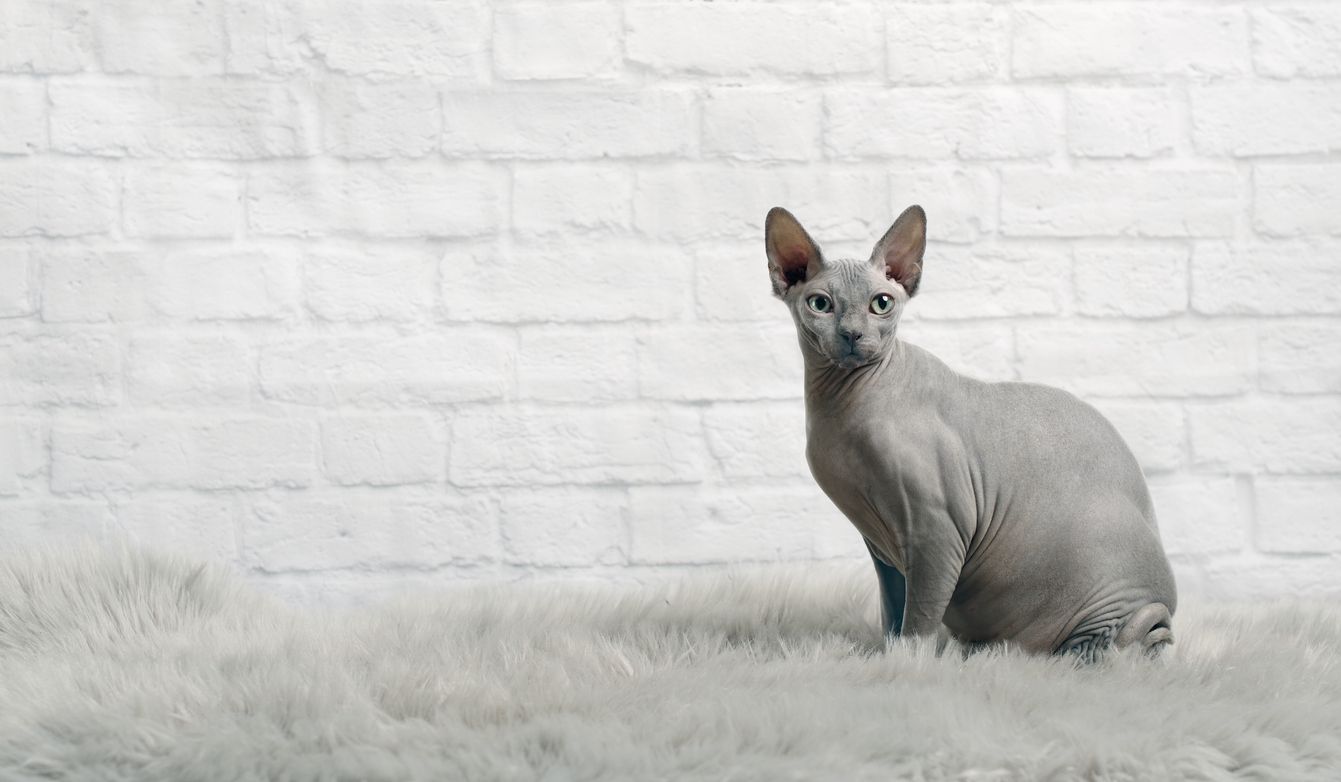How to prevent and treat yeast skin infections in cats

Yeast dermatitis is an uncommon fungal skin infection in cats that results from an overpopulation of yeast. Yeast are fungal organisms that normally live on the surface of the skin without causing problems, but the population can flourish when conditions are right. Treatment options for yeast skin infections in cats include antifungal medications, medicated baths, and managing the underlying factors that made conditions favorable for yeast overgrowth. If your cat has been diagnosed with yeast dermatitis, read on to learn:
- How cats get yeast skin infections
- Yeast infection symptoms in cats
- How yeast dermatitis is diagnosed and treated
- How pet parents can prevent yeast infections in their cat
Changes in the skin biome, lowered immunity, or moisture trapped on the skin can lead to a yeast skin infection, so proper management of these issues is critical for treatment and prevention. Bacterial infections, allergies, other fungal infections, systemic diseases, and skin folds can all contribute to yeast dermatitis in cats.
What is a yeast skin infection?
A yeast skin infection (yeast dermatitis) develops when there’s yeast overgrowth on the skin. Yeast are types of fungi that are part of the normal flora of a cat’s skin. However, yeast are opportunists, meaning that when conditions are right, the population may grow to the point of causing problems.
There are many species of yeast, but Malassezia is the one most commonly associated with yeast dermatitis in cats. Other types of yeast, such as Candida and Cryptococcus, are less common in opportunistic infections, as they are typically associated with systemic illness rather than superficial skin infections in cats.
Risk factors that can contribute to an overgrowth of yeast on the skin include:
- Skin inflammation from allergies, seborrhea, or other skin issues
- A lowered immune system from infectious diseases, such as FIV or FeLV
- Altered skin health from systemic illnesses, such as diabetes mellitus
The chances of yeast overgrowth are also increased by anything that causes moisture to be trapped against the skin, such as:
- Diaper use
- Clothing that is binding or too tight
- Wet bedding
- Anatomical factors, such as skin folds
Skin folds — such as those that occur due to obesity or in breeds with flat faces (brachycephalic) — can trap moisture, increasing the risk of a yeast infection.
Yeast infections on the skin are unlikely to be life-threatening, but underlying conditions that contribute to the infection can be severe.
Yeast skin infections are not the same thing as ringworm, or dermatophytosis, which is a different type of fungal skin infection and is much more common in cats than yeast dermatitis.
Symptoms of yeast dermatitis in cats
Clinical signs of yeast dermatitis in cats can include:
- Itchy skin
- Rash or inflamed skin
- Excessive licking or grooming
- Persistent acne
- Scaly, crusty, or flaky skin
- Discolored fur
- Foul odor from the skin
- Greasy skin and coat
Signs of yeast overgrowth may affect only a few spots or large areas across the body. Signs are more likely to occur where the skin is warmer or more moist due to being in contact with other areas of skin. At-risk areas include:
- Skin folds
- Ear canals
- Armpits
- Flanks
- Chin or lips
- Folds near the base of the tail
- Between toes
- Around the vulva
Yeast dermatitis symptoms often develop gradually rather than suddenly. Itchy skin is often one of the most obvious and common symptoms of yeast dermatitis. Cats may develop skin lesions or hair loss from scratching. Other clinical signs may be present depending on the underlying health issues or environmental factors that contributed to the infection.
Other health conditions with similar clinical signs
Clinical signs of yeast skin infections can be similar to those of other skin conditions, such as:
- Flea allergy dermatitis
- Other forms of allergic skin disease due to environmental or food allergies
- Bacterial skin infection
- Ringworm and other fungal infections
- Mites and other external parasites
- Autoimmune disorders, such as pemphigus
Yeast most commonly overgrow on the skin or in the ears in cats, causing yeast dermatitis or yeast otitis respectively.
Cat yeast skin infections are not to be confused with yeast infections or vaginitis in humans. Vaginal discharge in cats, for example, is unlikely to be related to a yeast infection. Instead, it’s far more likely to be associated with a uterine infection called pyometra, which is an emergency and warrants immediate veterinary care.
It’s important to get an accurate diagnosis from a veterinarian to determine an effective treatment plan for your cat’s skin condition. Different health issues with similar clinical signs may require different treatment methods.
Diagnosis and treatment options for yeast dermatitis in cats
When a cat presents with itchiness and other skin symptoms, a veterinarian, after a physical examination, may recommend diagnostic tests to determine the cause of the symptoms. Tests may include:
- Examination of skin scrapings under a microscope (skin cytology)
- Fungal culture
- Blood tests
- Urinalysis
- Skin biopsy
“Because yeast dermatitis is an opportunistic infection, determining the underlying cause of the yeast overgrowth is an essential part of the diagnostic process,” states Dr. Jo Myers, a veterinarian on the Vetster platform. “The infection is likely to recur if the underlying issue is not treated.” Treatment for yeast skin infections in cats includes:
- Oral or topical antifungals
- Medicated shampoo
- Anti-itch medication
Additional treatment methods may be needed and vary depending on the underlying cause of the infection.
Can I treat my cat’s yeast infection at home?
The first step is determining if your cat’s symptoms are due to yeast or something else, and that requires seeing a veterinarian. Treatment of yeast dermatitis can take weeks to months, so the majority of care is given at home. Yeast infections of the skin usually do not require hospitalization. Depending on the underlying cause, treatment for the contributing health or environmental issue may require lifelong management to prevent future infections. An online vet can help with long-term treatment and management of chronic health issues.
Preventing yeast skin infections in cats
The best way to prevent yeast skin infections in your cat is to manage factors that favor yeast overgrowth, such as:
- Allergies
- External parasites
- Diabetes
If a cat must wear diapers, frequent changes are necessary to maintain skin health. Any clothing should fit properly and be laundered regularly. Clean and dry bedding is also a necessity, especially for cats who are ill or have mobility limitations. In rare cases, surgical correction of skin folds may be recommended to prevent recurrent yeast infections. Keeping cats at a healthy weight can help prevent skin folds as well as other health issues that may contribute to yeast overgrowth.
If your cat is predisposed to yeast dermatitis due to their health or anatomy, a veterinarian may recommend additional preventative care, such as:
- Regular bathing with medicated shampoo
- Repeated use of antifungal medication
- Cleaning of facial or other skin folds
Inappropriate cleaning of skin folds can make things worse, so it’s always best to talk to a veterinary professional before using any products to try to prevent or treat yeast infections on your cat.
FAQ - How to prevent and treat yeast skin infections in cats
What does a yeast infection look like in cats?
Yeast are an uncommon cause of infections in cats but most often affect the skin or ears. Signs include either isolated spots or widespread areas of skin that are scaly and crusty, which can be either dry or greasy. Affected areas are also often smelly. Warm, moist areas of skin are more likely to be affected, such as in the ear canal and between folds of skin. Some of the most common signs of yeast dermatitis are itchy, crusty, and often smelly patches of hair loss.
How can I prevent a yeast skin infection in my cat?
Yeast infections of the skin are opportunistic, so the best way to prevent them is to manage underlying medical conditions or environmental factors that contribute to the development of yeast dermatitis. Food and environmental allergies, diabetes, other skin infections, and external parasites can all contribute to an overgrowth of yeast on the skin. Skin that remains warm and moist in skin folds or with diaper or clothing use is also at risk for infection. Talk to a vet about the best way to keep these areas clean and dry to prevent yeast skin infections.
What is the best treatment for a yeast skin infection in cats?
Yeast are fungi, so yeast infections on the skin are treated with oral and topical antifungal medications and medicated shampoos. Yeast skin infections are usually caused by an underlying health issue or environmental factor. These issues need to be addressed and treated or the infection is likely to recur.
Disclaimer: This article, its content, and its related references do not constitute veterinary advice and should not be considered a substitute for veterinary care. If your pet is showing any symptoms that could indicate a medical emergency, please seek immediate emergency care.




